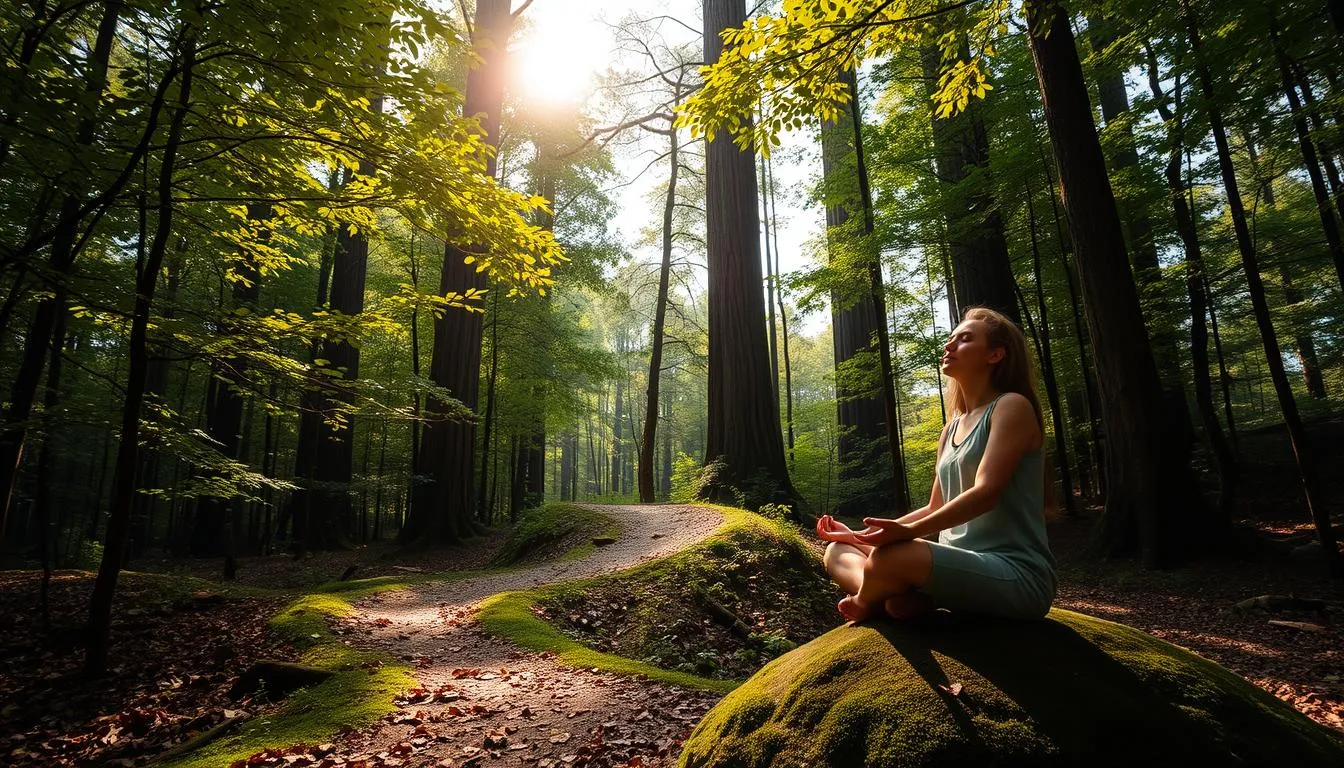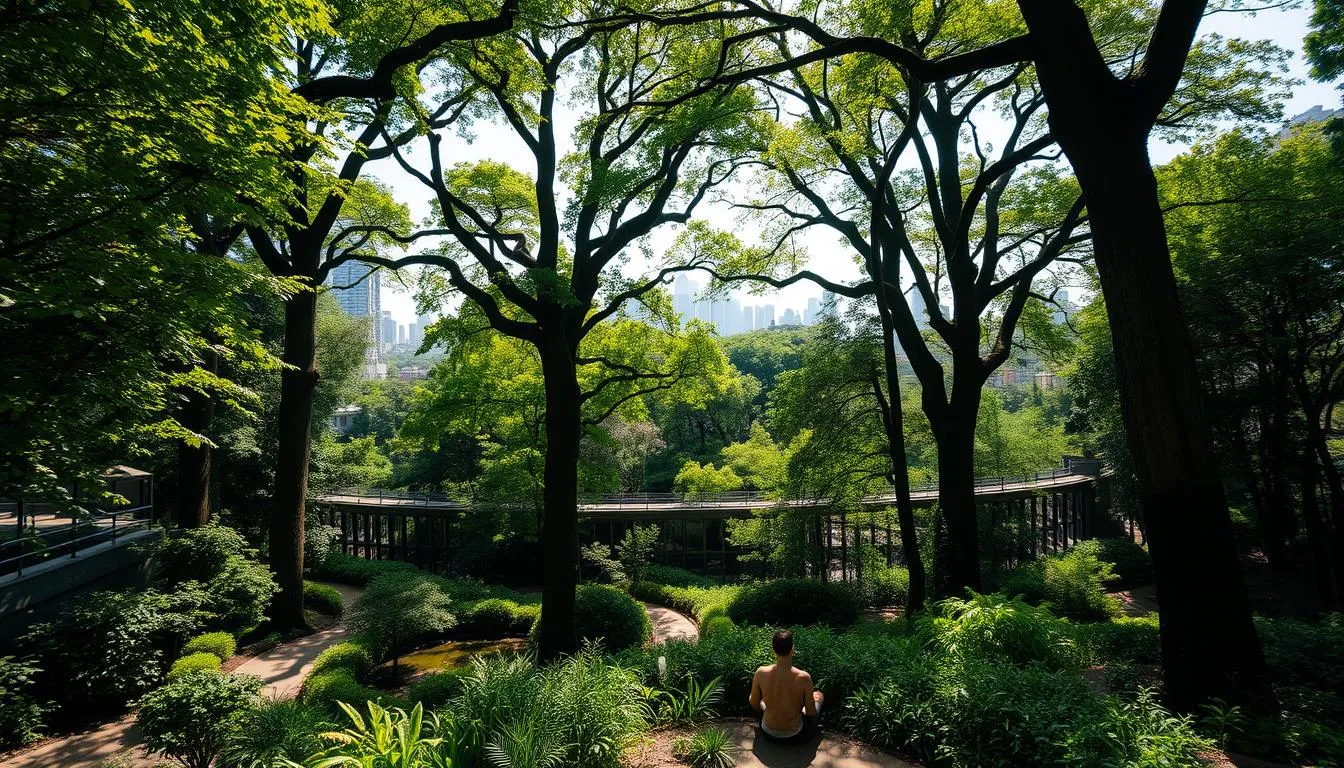I remember the first time I slowed down enough to notice the small things—the soft hush of leaves and the clean, cool air filling my lungs. That pause changed how I handled stress. It felt simple and strangely powerful.
Forest bathing is an inviting, beginner-friendly way to lower stress by spending time among trees and tuning into the sights, sounds, and smells around you. You don’t need special gear or long hikes—just a willingness to be present.
Research on shinrin-yoku suggests even short visits can calm the mind, ease the body, and support overall health. For complementary approaches to mental wellness, consider phototherapy for mood enhancement or explore aesthetic wellness treatments for relaxation. This guide will show the clear benefits, easy steps, and places in the U.S. where people can try it today. For more background on the practice, see this short guide from a conservation group: forest bathing overview.
Key Takeaways
- Forest bathing offers a gentle, accessible path to reduce daily stress.
- No special skills are needed—presence is more important than performance.
- Short sessions can improve mood and create a calmer mind and body.
- Spending time in fresh air and among trees supports overall health.
- This guide will cover how to try it, the science, and easy U.S. spots to visit.
Forest bathing for beginners: what it is and why it matters
What started in 1980s Japan as shinrin‑yoku grew into an accessible way to slow down and sense the world around us.
Forest bathing means immersing yourself in a natural setting with mindful attention. The practice shinrin-yoku began as a response to tech overload and soon became a form of ecotherapy embraced across the world.
From shinrin‑yoku to a modern mindfulness practice
Mindfulness in this practice asks you to notice without judging. You tune into your senses—sight, sound, scent, and touch—and let each moment arrive as it is.
Yūgen, komorebi, and wabi‑sabi: the concepts behind the calm
Three Japanese ideas shape the mood: yūgen for quiet awe, komorebi for light through leaves, and wabi‑sabi for imperfect beauty. These concepts help people relax into presence.
Forest therapy vs. a simple walk: engaging all your senses
Forest therapy often uses guided, sensory invitations. A trained guide may suggest focused practices to deepen the experience. A casual walk can be restorative, but therapy intentionally engages the senses and structure.
| Approach | Main focus | When to try |
|---|---|---|
| DIY walk | Movement and fresh air | Daily local green spaces |
| Guided therapy | Structured sensory practice | First-timers or deep practice |
| Travel to iconic sites | Extended immersion and awe | Special trips and vacations |
Science-backed health benefits of spending time in nature
Science increasingly finds that short, intentional visits to natural settings ease mental strain and boost wellbeing.
Lowering stress: Multiple studies report drops in cortisol after guided nature sessions. A 2007 study found clear cortisol reductions, which line up with the calming effects people describe when they unplug and slow their pace.
Mood and mental health: Research consistently shows reduced anxiety and depressive symptoms and better sleep after regular time outdoors. Sensory immersion redirects attention away from negative thoughts and works a bit like meditation.

Immune support and oxygen-rich air
Trees release phytoncides—plant compounds linked to higher natural killer cell activity in a 2010 study. These molecules, plus cleaner, oxygen-rich air, may help the body feel more resilient.
Blood pressure and other markers
Some work (2011) found improvements in blood pressure and adiponectin. But later studies show mixed results, so view these outcomes as promising, not guaranteed.
| Benefit | Evidence strength | Practical takeaway |
|---|---|---|
| Stress reduction (cortisol) | Moderate — repeated positive studies | Short sessions can lower stress hormones |
| Mood and sleep | Strong — consistent improvements | Regular time outdoors often eases anxiety and aids sleep |
| Immune markers (NK cells) | Moderate — some robust findings | Phytoncides may boost immune activity after repeated exposure |
| Blood pressure | Mixed — early positive, later inconsistent | May improve for some; not a guaranteed outcome |
What this means for you: The concept offers low-risk, tangible mental health benefits and potential physical gains. Consistency matters—regular practice amplifies effects much like meditation. Aim to feel calmer, sleep better, and think more clearly; improved physical markers are a welcome bonus when they occur.
How to practice forest bathing step by step
Begin by turning off your phone and deciding to move with curiosity rather than speed. Take a breath, loosen your shoulders, and give yourself permission to slow down for this moment.
Prepare your mind and body: slow pace, no phone, gentle intentions
Start small. Set a soft intention—reduce hurry, notice the present, and let your body relax before you walk.
Silence notifications and tuck your device away. This short digital detox helps the mind settle and lets the practice feel real.
Sensory invitations: sights, sounds, scents, touch, and breath
Use simple invitations to your senses. Track shifting sights of light on leaves and listen for layered sounds like birds and wind.
Gently touch bark or moss if it feels safe. Follow a steady breath; when thoughts wander, note them and return your attention. This is moving meditation made easy.

Time and frequency: minutes to hours, building a daily practice
Even 15 minutes can calm the mind and body. Aim for short sessions during the week and longer hours on weekends to deepen benefits.
Dr. Susan Albers suggests a brief daily breath practice at home to help you recenter quickly and carry calm into daily life.
Safety and comfort: seasons, trails, and mindful movement
Pick easy trails for the season, wear layers, and use sturdy shoes. Move mindfully on uneven ground and stay hydrated.
For first-timers, consider a certified guide or a local therapy group to learn pacing and invitations without pressure.
- Set a gentle intention and silence distractions.
- Invite senses: sights, sounds, scents, touch, and breath.
- Start with minutes, build to hours; practice regularly.
- Prioritize safety: proper trail choice, clothing, and shoes.
Forest bathing when you live in the city
Urban green spaces offer real mental benefits when you slow down and tune into your senses. City life can feel fast, but short visits to local greenways or small parks help reduce stress and clear the mind.
City parks and green spaces: what the studies suggest
A 2022 study found walking in actual forests gave stronger cardiovascular effects than walking in a city park. Still, parks in the city boost mood, improve heart-rate variability, and sharpen memory for many people.
Practical takeaway: use nearby parks for regular, short sessions to support daily life and health.
Bring nature indoors: plants, fresh air, and forest sounds
When travel out of the city is hard, bring elements of the outdoors inside. Keep a few low-maintenance plants, crack a window for fresh air, or play recordings of woodland sounds to cue relaxation.
Try pine or woodsy essential oils sparingly to evoke a calmer mood between outings.

Grounding tools and cautions: what to know before you try
Grounding mats and similar devices exist, but evidence is mixed. Read instructions carefully and inspect gear before each use to stay safe.
- Pick quieter hours in parks to avoid noise and get more benefit.
- Sit under city trees, notice breathing, and pause for two to five minutes.
- Stack short sessions through the week and plan occasional trips to real forests for a deeper reset.
Forest bathing
A guided session can turn a simple walk into a deep sensory practice that slows the mind and sharpens attention.
Guided experiences: what certified forest therapy guides do
Certified guides lead paced, two- to three‑hour ecotherapy walks. They offer gentle invitations to your senses and hold space so your experience can unfold naturally.
Expect unhurried walking, quiet observation, and an optional closing circle to reflect. Guides help beginners feel safe and teach simple meditation-like prompts.
DIY mindfulness in forests, parks, and near water
You can practice alone or with a friend. Set a time window, silence your phone, and move slowly.
Notice one sense at a time. Pause often, sip tea or jot a gratitude note at the end to seal the habit.
| Type | Typical length | What to expect |
|---|---|---|
| Guided therapy | 2–3 hours | Paced invitations, quiet reflection, novice support |
| Solo DIY | 15–90 minutes | Flexible pacing, sensory focus, low cost |
| Travel workshops | Half-day to multi-day | Local guides, deeper immersion, cultural notes |
Spotlight: Adirondack Riverwalking (Lake Placid/Saranac Lake) and Forest Bathing Hawai‘i run year-round guided experiences. When you travel, seek local guides to learn about native ecosystems and enrich your time in nature.
Where to go: U.S. national parks and beyond
Pick your destination with calm in mind—wide views, quiet trails, or a shaded grove all shape how you feel.
Adirondack Park, New York: evergreens, phytoncides, and four-season walks
Adirondack Park spans over six million acres and offers about 2,000 miles of trails. Native evergreens release aromatic phytoncides that many find soothing.
Some needles (spruce, eastern hemlock, balsam, pine) have traditional uses and can be brewed as tea, but always verify plant identification before use.
“Adirondack Riverwalking runs guided sessions year-round for visitors who want deeper guided experiences.”
Finding nearby options: parks, trails, and guides
Look up national parks, state parks, and urban trail systems to find accessible sites near home or while you travel.
Local guides can deepen your practice and teach regional ecology. When available, book one to learn safe, respectful ways to connect.
Sustainable travel and etiquette
Practice Leave No Trace: pack out trash, stay on trails, and protect plants and soil. Honor local customs and the people who steward these life‑giving places.
Plan quieter hours, bring water and layers, and linger where the sounds and light invite you to rest.
| Destination | Why visit | Tip |
|---|---|---|
| Adirondack Park, NY | Vast evergreens, year-round trails, phytoncide-rich air | Consider guided walks like Adirondack Riverwalking |
| Hawaii | Lush native trees and aromatic flowers | Join local guides such as Forest Bathing Hawai‘i |
| International picks | Costa Rica, New Zealand, Kenya offer deep immersion | Respect sacred sites and local protocols when you travel |
For ideas on U.S. options and how others are exploring national parks, see this short guide: forest bathing in America.
Conclusion
A short, sensory session once or twice a week can quietly change how your mind and body handle stress.
Forest bathing is a low‑pressure way to care for both physical and mental health. It offers real benefits you can feel in the moment and carry into everyday life.
Science shows clear mood and relaxation gains, with evolving results on blood and blood pressure—promising, not a medical cure. For deeper reading on measured immune and stress effects, see this review on clinical findings: forest therapy research.
Pick a nearby park or trail this week, set a small time, and try a gentle, sensory‑first session. Mix guided therapy with solo practice, and let regular short visits build steady benefit across travel and home life.
Breathe, notice, and let the trees meet you where you are; the advantages grow as you keep showing up.
FAQ
What is forest bathing and how does it differ from a regular walk?
Forest bathing, derived from the Japanese practice shinrin‑yoku, is a slow, mindful way of spending time among trees and green spaces to engage all your senses. Unlike a brisk or goal‑oriented walk, it emphasizes quiet observation, deep breathing, and sensory invitations—sight, sound, scent, touch—to reduce stress and boost mental clarity.
How long should a session last to feel benefits?
Start with 20–30 minutes to notice immediate calm and lowered stress. For stronger effects on mood, sleep, and immune markers, aim for 1–2 hours once or twice a week. Consistency matters more than duration: short daily sessions can be as helpful as longer occasional outings.
What mental health benefits can I expect?
Time in nature can reduce anxiety and depressive symptoms, improve mood, enhance sleep quality, and lower perceived stress. Research links these experiences to reduced cortisol and better emotional regulation, especially when combined with mindfulness practices.
Are there measurable physical health effects?
Studies show potential benefits like lower blood pressure, improved heart‑rate variability, and temporary boosts to immune function via phytoncides—natural compounds released by trees. Evidence varies, so use these practices as a supportive health habit rather than a medical treatment.
How can beginners practice safely and comfortably?
Wear sturdy shoes, dress for the weather, pack water, and choose well‑marked trails. Start slow, leave phones on silent, and set gentle intentions. Share your plan with someone if you go alone, and respect seasonal hazards like ticks or icy paths.
Can people in cities still benefit?
Yes. City parks, community gardens, and tree‑lined streets offer meaningful benefits. If you lack nearby green space, bring elements indoors—houseplants, fresh air, natural light, or recorded nature sounds—to mimic the calming effects.
What is a certified forest therapy guide and do I need one?
Certified guides, from organizations like the Association of Nature and Forest Therapy, lead structured sessions that deepen sensory engagement and group reflection. You don’t need a guide to try these practices, but guided experiences can help beginners learn techniques and feel held in a group setting.
How does this relate to cultural concepts like yūgen or wabi‑sabi?
Practices rooted in Japanese aesthetics—yūgen (profound subtlety) and wabi‑sabi (beauty in imperfection)—encourage mindful appreciation of natural moments. These ideas support slowing down, accepting transience, and finding calm in ordinary sights like dappled light or rustling leaves.
Are there risks or contraindications?
Risks are low but real: allergies, insect bites, falls, and extreme weather. People with severe psychiatric conditions should consult a mental‑health professional before starting new nature‑based therapies. Always follow local trail safety and medical advice for chronic conditions.
Where can I find suitable places in the U.S. for longer outings?
U.S. National Parks, state parks, and large preserves like Adirondack Park in New York offer diverse habitats and year‑round access. Check park websites for trail maps, seasonal access, and Leave No Trace guidelines to plan sustainable visits.
How can I integrate this into daily life without traveling far?
Create micro‑sessions: step outside during breaks, sit quietly beneath a tree, practice five minutes of mindful breathing on a bench, or care for plants at home. Small, regular habits build resilience and bring many of the same benefits as longer visits.
What tools help deepen the practice?
Simple tools include a small journal, a lightweight blanket, binoculars for birdwatching, and guided audio meditations focused on nature. Use these to focus attention, record sensory details, and track mood changes over time.
